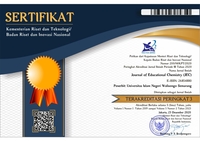Dancing with Falsification: The Dynamic of Chemistry Atomistic Theories Across Centuries
DOI:
https://doi.org/10.21580/jec.2023.5.2.19054Keywords:
falsification, atomic theory, chemistryAbstract
This research aimed to explore the contribution of the falsification process to the progress of science in the field of atomic theory. The analysis focused on the history of atomic development and how this theory underwent a process of falsification. This research was qualitative research using a literature study with a narrative review method. The results showed that the development of a theory, including the theory of atoms, has undergone many improvements. Falsification is an essential aspect of scientific progress, especially in atomic theory, involving testing the theory through experimentation and observation to determine accuracy. In the development of atomic theory, falsification played a key role, as in Dalton's atomic theory. Although revolutionary, subsequent experiments revealed subatomic particles, resulting in the falsification of Dalton's ideas and the emergence of a more complex understanding of atomic structure. The evolution of atomic theory shows that scientific knowledge is dynamic, continuing to develop through falsification. New evidence continues to refine ideas, ensuring scientific knowledge accurately reflects the natural world. The scientific method emphasizes openness to falsification, stating that theories must be testable and can be replaced when significant evidence refutes the theory. This openness is the basis for scientific progress and a deeper understanding of the universe.
Downloads
References
Chang, R. 2005. Kimia Dasar: Konsep-konsep Inti, Edisi ketiga, Jilid 1 (1st ed.). Jakarta: Erlangga.
Couvalis, G. 1997. The Philosophy of Science : Science and Objectivity. New York: Sage Publication.
Dainton, B. 2023. The Silence of Physics. Erkenntnis, 88(5), 2207–2241. https://doi.org/10.1007/s10670-021-00450-5
Fritzsche, S., Palmeri, P., & Schippers, S. 2021. Atomic Cascade Computations. Symmetry, 13(3), 520. https://doi.org/10.3390/sym13030520
Green, B. N., Johnson, C. D., & Adams, A. 2006. Writing Narrative Literature Reviews for Peer-Reviewed Journals: Secrets of the Trade. J Chiropr Med. ,5(3), 101–117.
Hayashi, M. 2017. Quantum Information Theory Mathematical Foundation Second Edition (2nd ed.). Berlin: Springer Verlag Berlin Heidelberg. http://www.springer.com/series/8431
Hon, G., & Goldstein, B. R. 2013. J. J. Thomson’s Plum‐Pudding Atomic Model: The Making of a Scientific Myth. Annalen Der Physik, 525(8–9). https://doi.org/10.1002/andp.201300732
Kozlov, M. G. 2021a. Some Current Trends in Atomic Theory. In Symmetry, 13(8), 1486. https://doi.org/10.3390/sym13081486
Kozlov, M. G. 2021b. Some current Trends in Atomic Theory. In Symmetry, 13(8), 1486. https://doi.org/10.3390/sym13081486
Kragh, H. 2021. Chemical and Other Aspects of Rutherford’s Nuclear Atom. Journal of the Royal Society of New Zealand, 51(3–4), 513–527. https://doi.org/10.1080/03036758.2020.1858879
Krisna Pradana, A. 2018. Atom Si Demokritus. Jakarta: PTIQ Press.
Lemma, A., & Belachew, W. 2022. How Worthy is Dalton’s Pursuit of Chemical Atomism for the Prospective Teachers? A case of Kotebe University of Education, Ethiopia. In Journal of Chemistry Education Research, 6(2), 138-151.
Marsiti. 2018. Materialisme Atom Democritus, In Cara Kerja Ilmu. Jakarta: PTIQ.
Mustofa, I. 2017. Fisika Atom sebagai Basis Filosofis Ilmu dalam Perspektif Al-Ghazali. Epistemé: Jurnal Pengembangan Ilmu Keislaman, 12(1), 53-75. https://doi.org/10.21274/epis.2017.12.1.53-75
Park, E. J., & Light, G. 2009. Identifying Atomic Structure as a Threshold Concept: Student Mental Models and Troublesomeness. International Journal of Science Education, 31(2), 233–258. https://doi.org/10.1080/09500690701675880
Popper, K. R. 1963. Science as Falsification. http://www.stephenjaygould.org/ctrl/popper_falsification.html
Riski, M. A. 2021. Teori Falsifikasi Karl Raimund Popper: Urgensi Pemikirannya dalam Dunia Akademik. Jurnal Filsafat Indonesia, 4(3), 261–272.
Salvi, P. R. 2023. Dalton’s Long Journey from Meteorology to the Chemical Atomic Theory. Substantia, 7(2), 101–119. https://doi.org/10.36253/Substantia-2126
Sujito, S., Sunardi, S., Ma’ruf, M., & Hartini, S. 2019. Paradigma Teori Atom Lintas Waktu. Jurnal Filsafat Indonesia, 2(1), 42–51.
Sylvester, A., Tate, M., & Johnstone, D. 2013. Beyond Synthesis: Re-presenting Heterogeneous Research Literature. Behaviour and Information Technology, 32(12), 1199–1215. https://doi.org/10.1080/0144929X.2011.624633
Ulya, I., & Abid, N. 2015. Pemikiran Thomas Kuhn dan Relevansinya terhadap Keilmuwan Islam. FIKRAH: Jurnal Ilmu Aqidah Dan Studi Keagamaan, 3(2), 249-276.
Wibowo, A. S. 2022. Falsifikasi menurut Karl Raimund Popper. In Cara Kerja Ilmu Filsafat dan Filsafat Ilmu. Jakarta: Kepustakaan Populer Gramedia.
Yerokhin, V. A., Patkóš, V., & Pachucki, K. 2021a. Atomic Structure Calculations of Helium with Correlated Exponential Functions. Symmetry, 13(7), 1246. https://doi.org/10.3390/sym13071246
Downloads
Published
How to Cite
Issue
Section
License
The copyright of the received article shall be assigned to the journal as the publisher of the journal. The intended copyright includes the right to publish the article in various forms (including reprints). The journal maintains the publishing rights to the published articles.
Authors are permitted to disseminate published articles by sharing the link/DOI of the article at the journal. Authors are allowed to use their articles for any legal purposes deemed necessary without written permission from the journal with an acknowledgment of initial publication to this journal.

This work is licensed under a Creative Commons Attribution-NonCommercial-ShareAlike 4.0 International License.


